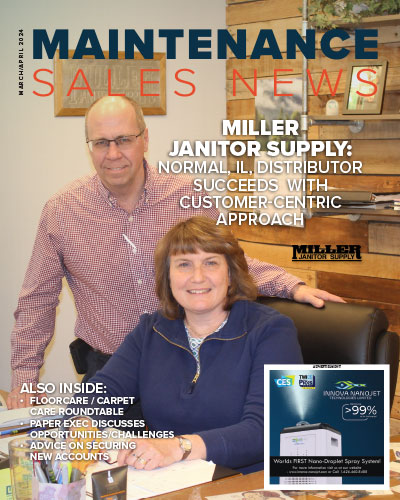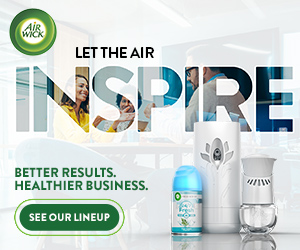Finding The Best Hand Hygiene Dispenser For Your Wellness Program
by Stephen Wagner, Senior Total Solutions Manager, GOJO Industries

Proper placement of hand soap and alcohol-based hand sanitizer dispensers is critical to an organization’s wellness program.
Hand hygiene is an essential practice, particularly in a business environment with many shared surfaces, common areas, and visitors or customers coming and going. Employees must practice good hand and surface hygiene to reduce the risk of spreading infectious germs, and the best way for businesses to promote this fundamental practice is to make easy access to quality hygiene products a part of maintaining a clean workplace. This includes offering quality hand soap at every sink and alcohol-based hand sanitizer (ABHS) in key locations throughout a facility, like where people gather and where there are shared surfaces.
Hand soap and ABHS dispensers are vital in fighting germs in a facility and are critical to an organization’s wellness program. Easily accessible dispensers and bottles act as visual cues to clean your hands. They also show you care about your employees’ and customers’ health and safety. Other benefits include:
- Portion control of the hand sanitizer or soap being dispensed;
- Larger refill volume than typically available via bottles, which makes them easier to maintain;
- Improved aesthetics and experience for users; and,
- Less clutter and less theft than bottles.
When maintaining a facility or campus, labor shortages, costs, and time on task are significant issues. Maintaining dispensers should not be a time-consuming task. The right dispenser can make maintenance easier and reduce customer complaints so that maintenance staff can focus on other important tasks.
With so many dispenser options available, what will offer the best hand hygiene solution for my facility?
- Find a dispenser that is easy to maintain and reliable. How easy is it to tell if the dispenser needs to be replaced? If you want touch-free dispensers, how easy is it to replace the battery and how often does that need to be done? Does the dispenser provide consistent product output (dose consistency maximizes germ kill)?
- Touch-free or manual? Manual dispensers have a simple push bar that is pressed to deliver the product. Manual-style dispensers offer simplified maintenance without batteries but also increase touchpoints. Touch-free dispensers have a sensor that, once activated, dispenses a pre-programmed amount of soap or hand sanitizer. The touch-free option can help reduce the transmission of germs, is easier and faster to use, and tends to suffer less from wear and tear. While they come with additional battery costs and maintenance needs, there are dispensers on the market that have the technology to overcome this burden.
- Where to place hand sanitizer dispensers. Instead of asking how many dispensers I need – the better question is, where do you need them to help create a safe and healthy working environment? Dispensers should be placed where they are most likely to be used at meaningful moments when people need hand sanitizer the most. Our Social and Behavioral Science team developed scientific principles around dispenser placement that our sales team is trained in. The best time to think about optimal dispenser placement is during a facility’s initial walk-through or site audit.
- What style of dispenser to use. Since dispensers are a visual reminder to clean your hands, the dispenser style is typically dictated by where you want to place it.
- Wall-mounted – when wall space is available nearby;
- Freestanding dispensers (floors and tabletops) – when walls aren’t nearby; and,
- Counter-mount soap dispensers provide the most permanent option and are ideal for high-traffic restrooms. (Consider top-fill counter-mount systems that reduce labor and help eliminate safety concerns, like removing heavy panels under a sink to refill dispensers).
- Look at what attributes the refills offer. Effectiveness and user experience are essential in hand hygiene products – they must kill or remove germs effectively and be pleasant to use (smell, touch, and feel). In addition, consider the following:
- Do you want hand soap, hand sanitizer, or both?;
- Do you want foam, liquid, or gel?;
- Fragranced or non-fragranced?;
- Is antibacterial soap necessary (like in healthcare settings)?;
- Consider purchasing products with third-party sustainability certifications, as those products have been assessed against industry-leading sustainability criteria, including biodegradability, packaging circularity, and environmental and human health hazards. Leading green building standards like LEED and WELL prioritize green cleaning products with third-party certifications like UL ECOLOGO®, Cradle to Cradle Certified®, and EPA Design for the Environment; and,
- Rely on a brand your employees and customers/visitors This sends a clear signal that your business prioritizes employee well-being and facility cleanliness and gives workers an extra boost of confidence.
- Choose dispensers that use factory-sealed refills. Refillable soap dispensers have been a known public health risk for many years – the CDC and WHO have issued guidance against this practice. Unfortunately, this practice has jumped into hand sanitizer dispensers because of supply constraints early in the pandemic. There is strong – and published – evidence that these systems can introduce contaminants (when the reservoir is opened to pour additional product in it), and in alcohol-based hand sanitizer dispensers, these open-style reservoirs can lead to alcohol evaporation and decrease the product’s effectiveness. “Topping off” the dispenser with different, potentially incompatible, products also comes with many other concerns. Without regular cleaning, refillable systems will grow bacteria and mold over time. Choosing factory-sealed refills eliminates these hazards and makes maintenance easier.
- Consider durability based on potential dispenser location. Certain locations require more rugged dispensers that can last longer and withstand frequent use or other extreme conditions, such as exterior spots exposed to fluctuating weather conditions, areas where vandalism may be a concern, and high-traffic areas. Dispensers located in “extreme” environments are typically made from more durable materials like stainless steel or fiberglass-reinforced plastics and can take a beating as well as endure the effects of direct sunlight and freezing temperatures.
- Advanced systems are available. Some facilities, especially in healthcare settings, can benefit from dispensers featuring remote-monitoring capabilities, so you can track your employees’ compliance with hand hygiene protocols or know which dispensers are ready for a refill. These systems are helpful for compliance-based facilities, like healthcare settings, or if you simply want to streamline your dispenser maintenance. As technology advances and these systems become more affordable, they are becoming more popular in foodservice locations as they allow an establishment to determine whether continuous improvement efforts are working.
About GOJO
GOJO has been developing innovative dispensers for more than 70 years – since our co-founder, Jerry Lippmann, invented the first-ever portion-control dispenser in 1952. For more information, visit GOJO.com.







